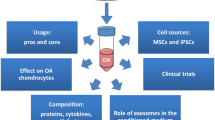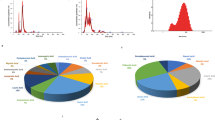Abstract
Background
Chondroitin sulfate (CS) has been used in cartilage tissue engineering techniques as a positive modulator of scaffolds. CS is a linear polysaccharide consisting of variously sulfated repeating disaccharides. The sulfation patterns of CS are closely related to their biological functions, but only monosulfated CS has been applied to scaffolds. In this study, we investigated the effects of various sulfation patterns of CS on chondrogenic differentiation using ATDC5 chondroprogenitor cells.
Methods
Disaccharide composition analysis of CS produced by ATDC5 cells at various differentiation steps was performed using high-performance liquid chromatography. ATDC5 cells were cultured with exogenously added, variously sulfated CS. Cell proliferation was analyzed by the 2-(2-methoxy-4-nitrophenyl)-3-(4-nitrophenyl)-5-(2,4-disulfophenyl)-2H-tetrazolium monosodium salt (WST-8) assay. Extracellular matrix production was evaluated by Alcian blue staining. Alkaline phosphatase (ALP) activity was evaluated using an ALP assay kit. Expression of chondrogenic markers was evaluated by real-time reverse transcription polymerase chain reaction (RT-PCR) or an enzyme-linked immunosorbent assay (ELISA) using a Type II Collagen Detection kit.
Results
The major components of CS produced by ATDC5 cells were 4-O-monosulfated disaccharides throughout chondrogenic differentiation. Low proportions of 4,6-O-disulfated disaccharides were also detected. Compared to the control group, which did not contain GAGs, the WST-8 assay indicated fewer viable cells when treated with CS-E, which are rich in 4,6-O-disulfated disaccharides. CS-E significantly enhanced Alcian blue staining in a dose-dependent manner and decreased ALP activity after 21 days of culture. Real-time RT-PCR showed that CS-E significantly enhanced all chondrogenic markers, col2a1, aggrecan, and sox9, either at day 4 or day 14 of culture. The results of ELISA analysis confirmed that CS-E significantly enhanced the production of type II collagen.
Conclusions
ATDC5 cells produced four different monosulfated or disulfated disaccharides in their extracellular matrices. The sulfation patterns of exogenously added CS affected chondrogenic differentiation of ATDC5 cells. In particular, CS-E rich in disulfated disaccharides significantly promoted chondrogenic differentiation of ATDC5 cells. Thus, CS containing this disulfated structure may be a useful scaffold component for enhancing chondrogenesis in cartilage tissue engineering.






Similar content being viewed by others
References
Brittberg M, Lindahl A, Nilsson A, Ohlsson C, Isaksson O, Peterson L. Treatment of deep cartilage defects in the knee with autologous chondrocyte transplantation. N Engl J Med. 1994;331:889–95.
Kasahara Y, Iwasaki N, Yamane S, Igarashi T, Majima T, Nonaka S, Harada K, Nishimura S, Minami A. Development of mature cartilage constructs using novel three-dimensional porous scaffolds for enhanced repair of osteochondral defects. J Biomed Mater Res A. 2008;86:127–36.
Uygun BE, Stojsih SE, Matthew HW. Effects of immobilized glycosaminoglycans on the proliferation and differentiation of mesenchymal stem cells. Tissue Eng Part A. 2009;15:3499–512.
Chen WC, Yao CL, Chu IM, Wei YH. Compare the effects of chondrogenesis by culture of human mesenchymal stem cells with various type of the chondroitin sulfate C. J Biosci Bioeng. 2011;111:226–31.
Park JS, Yang HJ, Woo DG, Yang HN, Na K, Park KH. Chondrogenic differentiation of mesenchymal stem cells embedded in a scaffold by long-term release of TGF-beta 3 complexed with chondroitin sulfate. J Biomed Mater Res A. 2010;92:806–16.
Varghese S, Hwang NS, Canver AC, Theprungsirikul P, Lin DW, Elisseeff J. Chondroitin sulfate based niches for chondrogenic differentiation of mesenchymal stem cells. Matrix Biol. 2008;27:12–21.
Sugahara K, Yamada S. Structure and function of oversulfated chondroitin sulfate variants: unique sulfation patterns and neuroregulatory activities. Trends Glycosci Glyc. 2000;12:321–49.
Sugahara K, Mikami T, Uyama T, Mizuguchi S, Nomura K, Kitagawa H. Recent advances in the structural biology of chondroitin sulfate and dermatan sulfate. Curr Opin Struct Biol. 2003;13:612–20.
Thiele H, Sakano M, Kitagawa H, Sugahara K, Rajab A, Hohne W, Ritter H, Leschik G, Nurnberg P, Mundlos S. Loss of chondroitin 6-O-sulfotransferase-1 function results in severe human chondrodysplasia with progressive spinal involvement. Proc Natl Acad Sci USA. 2004;101:10155–60.
van Roij MHH, Mizumoto S, Yamada S, Morgan T, Tan-Sindhunata MB, Meijers-Heijboer H, Verbeke JI, Markie D, Sugahara K, Robertson SP. Spondyloepiphyseal dysplasia, Omani type: further definition of the phenotype. Am J Med Genet. 2008;146A:2376–84.
Tuysuz B, Mizumoto S, Sugahara K, Celebi A, Mundlos S, Turkmen S. Omani type Spondyloepiphyseal dysplasia with cardiac involvement caused by a missense mutation in CHST3. Clin Genet. 2009;75:375–83.
Faiyaz ul Haque M, King LM, Krakow D, Cantor RM, Rusiniak ME, Swank RT, Superti-Furga A, Haque S, Abbas H, Ahmad W, Ahmad M, Cohn DH. Mutations in orthologous genes in human spondyloepimetaphyseal dysplasia and the brachymorphic mouse. Nat Genet. 1998;20:157–62.
Iida A, Simsek-Kiper PÖ, Mizumoto S, Hoshino T, Elcioglu N, Horemuzova E, Geiberger S, Yesil G, Kayserili H, Utine GE, Boduroglu K, Watanabe S, Ohashi H, Alanay Y, Sugahara K, Nishimura G, Ikegawa S. Clinical and radiographic features of the autosomal recessive form of Brachyolmia caused by PAPSS2 mutations. Hum Mutat. 2013;34:1381–6.
Mizumoto S, Ikegawa S, Sugahara K. Human genetic disorders caused by mutations in genes encoding biosynthetic enzymes for sulfated glycosaminoglycans. J Biol Chem. 2013;288:10953–61.
Shukunami C, Ishizeki K, Atsumi T, Ohta Y, Suzuki F, Hiraki Y. Cellular hypertrophy and calcification of embryonal carcinoma-derived chondrogenic cell line ATDC5 in vitro. J Bone Miner Res. 1997;12:1174–88.
Shukunami C, Ohta Y, Sakuda M, Hiraki Y. Sequential progression of the differentiation program by bone morphogenetic protein-2 in chondrogenic cell line ATDC5. Exp Cell Res. 1998;241:1–11.
Li F, Shetty AK, Sugahara K. Neuritogenic activity of chondroitin/dermatan sulfate hybrid chains of embryonic pig brain and their mimicry from shark liver. Involvement of the pleiotrophin and hepatocyte growth factor signaling pathways. J Biol Chem. 2007;282:2956–66.
Kinoshita A, Sugahara K. Microanalysis of glycosaminoglycan-derived oligosaccharides labeled with a fluorophore 2-aminobenzamide by high-performance liquid chromatography: application to disaccharide composition analysis and exosequencing of oligosaccharides. Anal Biochem. 1999;269:367–78.
Phornphutkul C, Wu KY, Yang X, Chen Q, Gruppuso PA. Insulin-like growth factor-I signaling is modified during chondrocyte differentiation. J Endocrinol. 2004;183:477–86.
Bayliss MT, Osborne D, Woodhouse S, Davidson C. Sulfation of chondroitin sulfate in human articular cartilage. The effect of age, topographical position, and zone of cartilage on tissue composition. J Biol Chem. 1999;274:15892–900.
Eliakim R, Gilead L, Ligumsky M, Okon E, Rachmilewitz D, Razin E. Histamine and chondroitin sulfate E proteoglycan released by cultured human colonic mucosa: indication for possible presence of E mast cells. Proc Natl Acad Sci USA. 1986;83:461–4.
Tsuchida K, Shioi J, Yamada S, Boghosian G, Wu A, Cai H, Sugahara K, Robakis NK. Appican, the proteoglycan form of the amyloid precursor protein, contains chondroitin sulfate E in the repeating disaccharide region and 4-O-sulfated galactose in the linkage region. J Biol Chem. 2001;276:37155–60.
Bao X, Mikami T, Yamada S, Faissner A, Muramatsu T, Sugahara K. Heparin-binding growth factor, pleiotrophin, mediates neuritogenic activity of embryonic pig brain-derived chondroitin sulfate/dermatan sulfate hybrid chains. J Biol Chem. 2005;280:9180–91.
Deepa SS, Umehara Y, Higashiyama S, Itoh N, Sugahara K. Specific molecular interactions of oversulfated chondroitin sulfate E with various heparin-binding growth factors. Implications as a physiological binding partner in the brain and other tissues. J Biol Chem. 2002;277:43707–16.
Gama CI, Tully SE, Sotogaku N, Clark PM, Rawat M, Vaidehi N, Goddard WA 3rd, Nishi A, Hsieh-Wilson LC. Sulfation patterns of glycosaminoglycans encode molecular recognition and activity. Nat Chem Biol. 2006;2:467–73.
Miyazaki T, Miyauchi S, Tawada A, Anada T, Matsuzaka S, Suzuki O. Oversulfated chondroitin sulfate-E binds to BMP-4 and enhances osteoblast differentiation. J Cell Physiol. 2008;217:769–77.
Shukunami C, Akiyama H, Nakamura T, Hiraki Y. Requirement of autocrine signaling by bone morphogenetic protein-4 for chondrogenic differentiation of ATDC5 cells. FEBS Lett. 2000;469:83–7.
Akiyama H, Shukunami C, Nakamura T, Hiraki Y. Differential expressions of BMP family genes during chondrogenic differentiation of mouse ATDC5 cells. Cell Struct Funct. 2000;25:195–204.
Bell E. Tissue engineering: a perspective. J Cell Biochem. 1991;45:239–41.
Conflicts of interest
None of the authors have any conflicts of interest to declare.
Author information
Authors and Affiliations
Corresponding author
About this article
Cite this article
Kawamura, D., Funakoshi, T., Mizumoto, S. et al. Sulfation patterns of exogenous chondroitin sulfate affect chondrogenic differentiation of ATDC5 cells. J Orthop Sci 19, 1028–1035 (2014). https://doi.org/10.1007/s00776-014-0643-y
Received:
Accepted:
Published:
Issue Date:
DOI: https://doi.org/10.1007/s00776-014-0643-y




